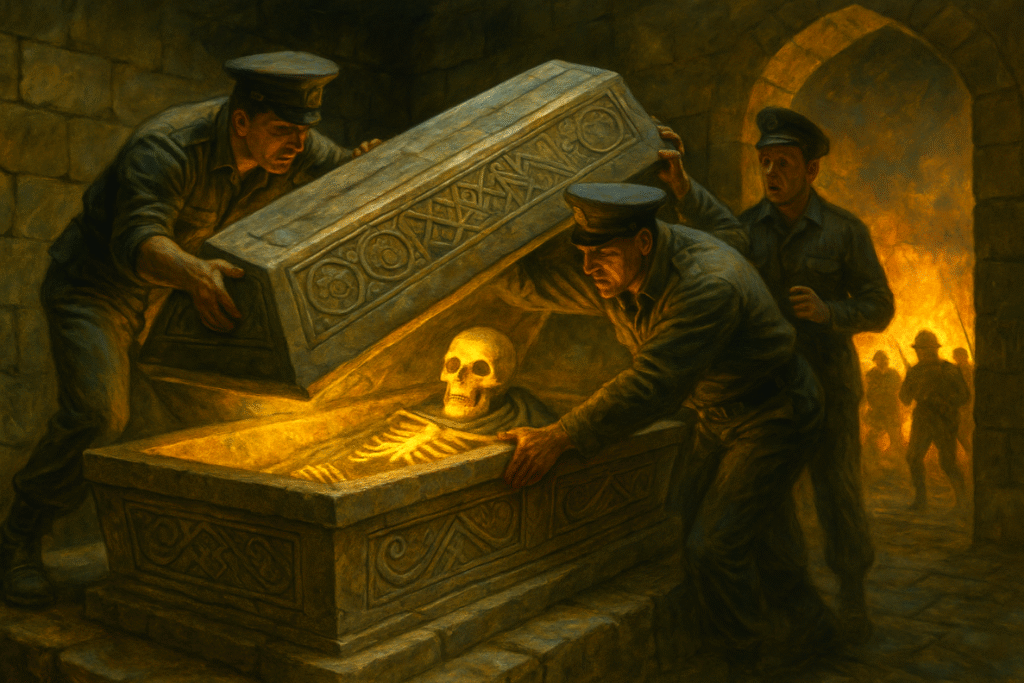Introduction to Timur and His Legacy
The figure of Timur, also known as Tamerlane, stands as one of the most formidable conquerors in history, often hailed as the last of the great nomadic conquerors. Born in 1336 in what is now Uzbekistan, Timur was a military genius who established a vast empire that stretched from the Middle East to India. His legacy is a complex tapestry woven from brutal warfare, impressive cultural patronage, and a keen architectural vision, particularly in his capital, Samarkand.
Timur’s successful campaigns and his rule, marked by ruthless ambition and strategic brilliance, solidified his place as a significant historical figure. His burial site, intricately designed and filled with rich symbolism and artistry, reflects his aspirations and the grandeur of the empire he built. At the same time, Timur’s history is tinged with bloodshed and death, giving rise to various myths and legends, including a particularly ominous tale—the curse of his tomb.
Historical Events Surrounding the Opening of the Tomb
Timur’s tomb is located in Samarkand, in a majestic mausoleum known as the Gur-e Amir, completed shortly after his death in 1405. Long revered as a cultural site, the mausoleum itself has attracted historians and archaeologists, but it wasn’t until 1941 that the tomb was officially opened for archaeological investigation. This event coincided with the dark clouds of the Second World War, creating a narrative that would weave together history, myth, and superstition.
Upon opening Timur’s tomb, a fascinating yet harrowing series of events ensued. The Soviet archaeologists, led by the prominent scholar Mikhail Gerasimov, uncovered the remains of Timur in a limestone coffin. The legends surrounding the curse began circulating almost immediately, amplified by the perceptions of those who believed that disturbing the rest of a great conqueror would lead to dire consequences.
The curse allegedly proclaimed that whoever disturbed Timur’s resting place would unleash death and destruction upon the world. Coincidentally, shortly after the tomb was opened, the rapid escalation of World War II began with the German invasion of the Soviet Union in June 1941. The timing sparked widespread speculation about the connection between Timur’s tomb and the ensuing global conflict, further embedding the story of the curse in popular consciousness.
Discussion on the Curse and Psychological Implications
The narrative of curses surrounding significant historical figures, especially conquerors and rulers, is deeply entrenched in myriad cultures. As humans, we often grapple with the implications of our actions, particularly when they interrupt something sacred or noteworthy. Timurid lore, reflecting a blend of Islamic and Central Asian traditions, speaks to the notion of respect for the dead, further complicating the psychological lens through which the curse of Timur’s tomb is viewed.
Cursed relics and sites often serve to anchor societal fears and provide a framework to explain disasters that might otherwise seem random or chaotic. In the case of Timur’s tomb, the psychological implications are rather profound. The fear of the curse could have influenced how individuals and nations interpreted the catastrophic events during and following the war. The idea that one man’s tomb—specifically that of a conqueror renowned for violence—could bring about immense destruction adds a mythical layer to the practical realities of war.
Moreover, this belief can be seen as a reflection of the anxieties of the time. When societies face unprecedented turmoil, attributing that chaos to an ancient curse may provide a sense of narrative control, making the incomprehensible more understandable. In essence, the curse of Timur serves as a psychological escape for those overwhelmed by the horrors of war, allowing them to find meaning in suffering through folklore.
Case Studies of Wars Linked to the Tomb’s Opening
1. World War II
The most immediate conflict thought to be associated with the opening of Timur’s tomb is World War II. The opening in 1941, coinciding with Operation Barbarossa, sparked speculation that the curse was at play. Within months of the tomb’s disturbance, Europe was engulfed in warfare, sparking fears of widespread destruction predicted by the myth of Timur’s vengeance.
Historian Eugene V. Buzgalin highlighted how ancient curses would become part of the broader narrative during the war, spurring tales that crippled morale. While no direct causation between the tomb’s opening and World War II can be definitively established, the psychological aftereffects of this belief played a crucial role in how people processed the massive scale of tragedy that unfolded.
2. The Afghan-Soviet War
After World War II, the implications of Timur’s curse continued to resonate within Central Asia. The Afghan-Soviet War (1979-1989), which was a significant conflict during the Cold War, also has tenuous links to the folklore surrounding Timur’s tomb. As Soviet forces entered Afghanistan, the geopolitical landscape began to shift drastically, losing grasp on the narrative of invincibility that had once characterized their military campaigns. Thus, many in the Afghan resistance viewed their struggle against the Soviets as a symbolic fight against tyranny, paralleling Timur’s historical battles.
Local legends resurfaced, bolstered by notions of the curse, as many believed that Timur’s spirit had risen to protect the Afghan homeland from invasion. Although anecdotal, these interpretations of historical narratives contributed to the psychology of resilience among the Afghan people, turning Timur into a national symbol during their struggle.
3. The Rise of Jihadist Movements
Another area where the legacy of Timur’s tomb and its supposed curse has become relevant is in the realm of jihadist movements in the post-9/11 era. The romanticized view of Timur among various Central Asian groups has created a narrative surrounding resistance and sovereignty. In this context, Timur is often invoked as a legendary figure who successfully expelled foreign invaders and unified disheartened factions under a single banner. The curse narrative serves to imbue their struggles with greater significance, blending historical and mythological motifs together.
Thus, Timur’s tomb becomes a symbol of local identity, reinforcing ties with one’s historical legacy while fueling the fire of current geopolitical tensions. As jihadist movements rose, stories of the curse were repurposed to ignite fervor and inspire resistance, showcasing how history and myth intersect in modern conflicts.
Conclusion: Summarizing Findings and Insights
The legacy of Timur, encapsulated in the stories surrounding his tomb, is multifaceted and has evolved over centuries. The supposed curse of Timur’s tomb illustrates how historical narratives can take on lives of their own, especially when underscored by a backdrop of war and turmoil.
While there is no concrete evidence linking the opening of Timur’s tomb with specific conflicts directly, the psychological and cultural implications of the curse have undeniably influenced perceptions of warfare through a mythological lens. From World War II to modern conflicts in Central Asia, tales of Timur’s wrath have persisted, shaping narratives and providing frameworks through which individuals process violent and chaotic events.
Ultimately, the curse of Timur’s tomb serves as an example of how history and myth converge, illustrating the profound impact cultural beliefs can have in interpreting and understanding wars and conflicts across time.
FAQ Section
What is the curse of Timur’s tomb?
The curse of Timur’s tomb refers to the belief that disturbances of Timur’s burial site would lead to destruction and war. This belief gained prominence after the tomb was opened in 1941, coinciding with the start of World War II.
Did the opening of Timur’s tomb directly cause wars?
While no direct correlation exists, the opening of Timur’s tomb and the subsequent onset of major conflicts, such as World War II, sparked widespread speculation and folklore regarding the curse’s influence.
How has folklore surrounding curses influenced cultural beliefs?
Folklore regarding curses serves to shape collective anxieties, providing narratives that help individuals and societies make sense of chaotic events, particularly during times of war.
Why is Timur a significant historical figure?
Timur is significant due to his conquests that created one of the last great empires in Central Asia. His influence extended beyond warfare, as his patronage led to advances in culture, art, and architecture.
Can curses have psychological effects on societies?
Yes, curses and related folklore can deeply affect collective psychologies. They offer narratives that help individuals process traumatic events, serve as coping mechanisms, or unify communities in response to perceived threats.
What has been the legacy of Timur’s tomb in modern conflicts?
The legacy of Timur’s tomb has been utilized symbolically by various groups to frame resistance against invasion and oppression, particularly in Afghan conflicts, where Timur is often revered as a national hero.


